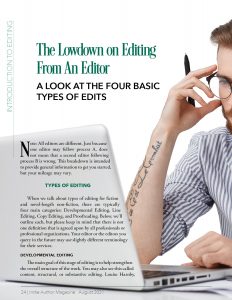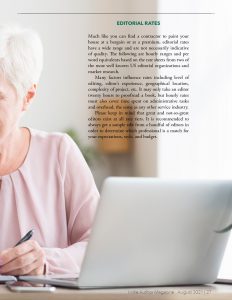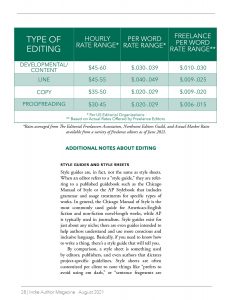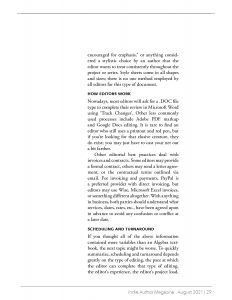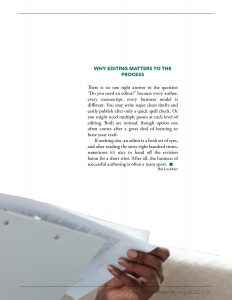An Editor's Guide to the Process
Note: All editors are different. Just because one editor may follow process A, does not mean that a second editor following process B is wrong. This breakdown is intended to provide general information to get you started, but your mileage may vary.
Types of Editing
When we talk about types of editing for fiction and novel-length non-fiction, there are typically four main categories: Developmental Editing, Line Editing, Copy Editing, and Proofreading. Below, we’ll outline each, but please keep in mind that there is not one definition that is agreed upon by all professionals or professional organizations. Your editor or the editors you query in the future may use slightly different terminology for their services.
Developmental Editing
The main goal of this stage of editing is to help strengthen the overall structure of the work. You may also see this called content, structural, or substantive editing. Louise Harnby, an editor well-respected in both the editor and author communities, sums it up in her Levels of Editing Webinar and companion free audio guide when she says, “This is big picture work that looks at your novel as a whole, focusing on how your book works for stuff like structure, plot, flow, point of view, characterization, and pace.” Under the developmental umbrella, additional services such as manuscript critique/evaluation, editorial assessments, beta reading, sensitivity reading, and fact-checking might also be found.
Line Editing
This type of editing is sometimes called “stylistic editing” because it is intended to improve the flow and style of the language. Line edits provide an opportunity for an editor to smooth the prose, enhance the author’s voice, and enrich the reader’s experience at the micro level. Line editing typically comprises sentence and paragraph level revisions to reorganize for impact, suggest stronger verbs and action, modify unintentional repetitive language, add cadence and rhythm, and further develop author voice and style.
Copy Editing
When it comes to application of spelling, grammar, and punctuation rules, the copy editor is in charge. Do you italicize the name of a poem? The copy editor will know. Misspelled recognizance? Your copy editor will fix that. Used a comma for a dialogue tag that’s not really a tag, but an action? Copy editors are on it. Where a line editor takes what is written and improves it, a copy editor takes what is written and corrects it.
Proofreading
In traditional publishing, a proofreader’s job is often different from the role a proofreader plays within the business model of self-publishing authors. Proofreaders in publishing houses are sometimes tasked with formatting and typesetting consistencies, though they may also catch those pesky ninja typos that hang on for dear life. However, freelance proofreaders in the indie publishing realm are often more like light copy editors. With or without the formatting tasks, proofreaders should always be considered the final stage of the editorial process.
Editorial Rates
Much like you can find a contractor to paint your house at a bargain or at a premium, editorial rates have a wide range and are not necessarily indicative of quality. The following are hourly ranges and per word equivalents based on the rate sheets from two of the most well known US editorial organizations and market research.
| TYPE OF EDITING | HOURLY RATE RANGE | PER WORD RATE RANGE | MARKET VALUE PER WORD RATE |
| DEVELOPMENTAL | $45-60 | .030–.039 | .010–.030 |
| LINE | $45-55 | .040–.049 | .009–.025 |
| COPY | $35-50 | .020–.029 | .009–.020 |
| PROOFREADING | $30-45 | .020–.029 | .006–.015 |
| *Per US Editorial Organizations | *Per US Editorial Organizations | *Based on Actual Rates Seen Offered by Freelance Editors |
*Rates averaged from The Editorial Freelancers Association, Northwest Editors Guild, and Actual Market Rates available from a variety of editors as of June 2021.
Many factors influence rates including level of editing, editor’s experience, geographical location, complexity of project, etc. It may only take an editor twenty hours to proofread a book, but hourly rates must also cover time spent on administrative tasks and overhead, the same as any other service industry.
Please keep in mind that great and not-so-great editors exist at all rate tiers. It is recommended to always get a sample edit from a handful of editors in order to determine which professional is a match for your expectations, style, and budget.
Additional Notes About Editing
Style Guides and Style Sheets
Style guides are, in fact, not the same as style sheets. When an editor refers to a “style guide,” they are referring to a published guidebook such as the Chicago Manual of Style or the AP Stylebook that includes grammar and usage treatments for specific types of works. In general, the Chicago Manual of Style is the most commonly used guide for American-English fiction and non-fiction novel-length works, while AP is typically used in journalism. Style guides exist for just about any niche; there are even guides intended to help authors understand and use more conscious and inclusive language. Basically, if you need to know how to write a thing, there’s a style guide that will tell you.
By comparison, a style sheet is something used by editors, publishers, and even authors that dictates project-specific guidelines. Style sheets are often customized per client to note things like “prefers to avoid using em dash,” or “sentence fragments are encouraged for emphasis,” or anything considered a stylistic choice by an author that the editor wants to treat consistently throughout the project or series. Style sheets come in all shapes and sizes; there is no one method employed by all editors for this type of document.
How Editors Work
Nowadays, most editors will ask for a .DOC file type to complete their review in Microsoft Word using ‘Track Changes’. Other less commonly used processes include Adobe PDF markup and Google Docs editing. It is rare to find an editor who still uses a printout and red pen, but if you’re looking for that elusive creature, they do exist; you may just have to cast your net out a bit farther.
Other editorial best practices deal with invoices and contracts. Some editors may provide a formal contract, others may send a letter agreement, or the contractual terms outlined via email. For invoicing and payments, PayPal is a preferred provider with direct invoicing, but editors may use Wise, Microsoft Excel invoices, or something different altogether. With anything in business, both parties should understand what services, dates, rates, etc., have been agreed upon in advance to avoid any confusion or conflict at a later date.
Scheduling and Turnaround
If you thought all of the above information contained more variables than an Algebra textbook, the next topic might be worse. To quickly summarize, scheduling and turnaround depends greatly on the type of editing, the pace at which the editor can complete that type of editing, the editor’s experience, the editor’s project load, and more. Some editors may only take one project per month, while others may work on several. A good rule of thumb is to reach out to potential editors at least ninety days in advance. Your favorite editor may be booked as far as six months to a year, so definitely don’t dally. As far as turnaround, for a line edit on a 50-80k manuscript, plan for two to four weeks, but always verify dates, and if possible, get them in writing.
Why Editing Matters to the Process
There is no one right answer to the question “Do you need an editor?” because every author, every manuscript, every business model is different. You may write super clean drafts and easily publish after only a quick spell check. Or you might need multiple passes at each level of editing. Both are normal, though option one often comes after a great deal of learning to hone your craft.
If nothing else, an editor is a fresh set of eyes, and after reading the story eight hundred times, sometimes it’s nice to hand off the revision baton for a short stint. After all, the business of successful authoring is often a team sport.
Bre Lockhart
Resources:
https://www.louiseharnbyproofreader.com/editing-levels.html
https://www.edsguild.org/editorial-rates
